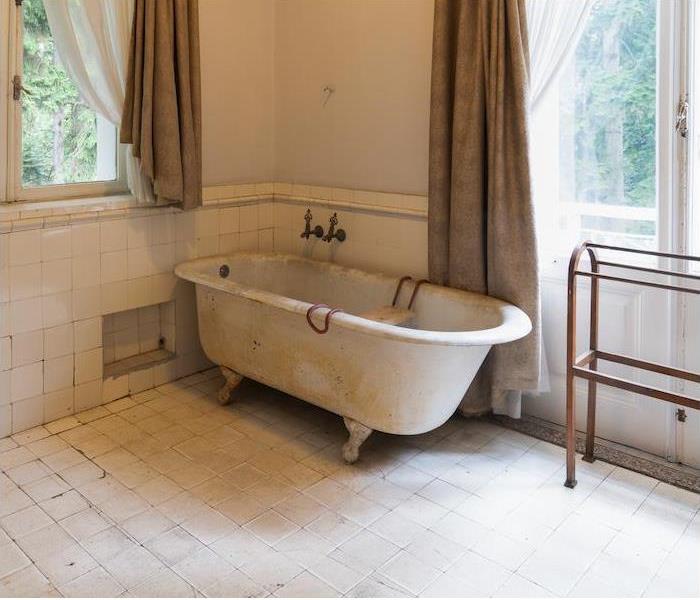What Can Cause a Leak in My San Antonio Bathroom?
4/20/2020 (Permalink)
 After a while, water starts to deteriorate the tile and structure of your bathroom. Contact team SERVPRO to evaluate & remediate the water damage.
After a while, water starts to deteriorate the tile and structure of your bathroom. Contact team SERVPRO to evaluate & remediate the water damage.
Expert Detection Skills and Tools Help SERVPRO Get the Fix on Hidden San Antonio Bathroom Leaks
It can be challenging to determine the source when the evidence of a San Antonio bathroom water loss shows up far from the cause. A significant percentage of households experience gradual damage from persistent moisture where no identifiable crisis like a burst pipe or toilet backup occurred. By the time you notice the problem, the situation can become complicated by the involvement of a range of building materials.
How Do I Know if I Have a Bathroom Leak?
You are not alone if your San Antonio’s bathroom water damage makes itself known first in another room or even on another level of your home. The damage in the bathroom itself can be invisible. There are many things restoration crews encounter that can indicate a water problem even if you do not see water puddled up in your bathroom.
What Are Visual Signs of a Suspected Bathroom Leak?
Structural components affected by excess moisture in your bathroom can swell or discolor. The water frequently migrates away from the footprint of your bath inside building cavities, following plumbing and electrical conduit or framing materials, showing up as:
- Warping of the floor or wet carpeting next to the shared wall in a room or hall adjoining the bathroom
- Staining or disintegration of the ceiling on the level below the bathroom
- Bulging or blistering of paint on a wall on the level below the bathroom
Can Odors Signal Bathroom Water Damage?
It can take some time for the moisture to collect or saturate building materials enough to show physical damage. Odors are frequently a first sign, manifested as follows, among other ways:
- A smell of damp wood caused by water dripping on framing, backer board, lath, or drywall
- An odor of “sewer gas” caused by a loose toilet seal
- A “musty” smell that can signal mold growth in a variety of hidden spaces fueled by bathroom moisture
Are There Signs of Damage I Am Missing Right in the Bathroom?
Even if you do not see dripping from a pipe or excess water on the floor after a shower, your bathroom can reveal damage. Here are some concerning items to note:
- Ceramic tiles on the floor or wall coming loose, indicating water has invaded through cracked or unsealed grout
- Areas of the floor might seem “spongy,” perhaps because the subfloor is wet and weakening
- Streaks of mildew or mold on grout, tile, walls, ceilings
- Moisture beading up on surfaces, including persistent fogging-up of mirrors, glass, and chrome surfaces
Why Does Water Get Out of Control in the Bathroom?
One of the frustrations homeowners feel when their bathroom starts losing the battle of water containment is why the problems happen in the first place. The seemingly reasonable expectation that the water-rich environment of a bathroom should come complete with robust safeguards might be why the water damage in San Antonio begins. Skipping maintenance that enhances watertight features and failure to install or use moisture mitigation equipment expose the room to a heightened risk of water damage. Causes of the leakage and seepage that create moisture movement include:
- Unsealed, cracked, or missing grout around ceramic tiles
- Poorly maintained silicone seals around the joints between tubs, showers, and sinks
- Small leaks or broken connections in plumbing supply or waste pipes
- Dried out toilet or bidet seals
- Failure to contain shower curtains inside tubs
- Warped or unclosed shower doors
- Splashing or overflows of sinks, tubs, and spas
- Absence or inconsistent use of exhaust fans, driving humidity buildup
Who Can Help with Bathroom Water Damage Issues?
Because the damage can have diverse causes and migrate in intricate ways, it is crucial to engage the services of a firm whose technicians are highly trained and thoroughly experienced in water loss and migration of moisture. SERVPRO ensures that the crew we send to help has mastered the Institute of Inspection, Cleaning and Restoration Certification (IICRC) coursework in all aspects of water damage and structural drying best practices. We also invest in cutting-edge equipment that helps us detect and trace the journey water takes inside your home. Once the water and moisture-laden structures are identified, we use research-based strategies to remove the fluids and plan for efficient drying.
What Happens If the Underlying Water Risks Are Unresolved?
It can be tempting to pledge to do better and try to avoid some expenses by covering up stains with paint and using a consumer-grade wet vacuum on damp carpeting. Unfortunately, if comprehensive inspection and remediation go undone, it is nearly guaranteed that the damage will recur. The removal of standing water and drying is vital. Our team then works with you to make sure the root causes of the water damage resolve, including help in lining up plumbing repairs, installation or maintenance of exhaust systems, restoration of grout and sealants, and rehabbing of weakened floors or walls.
Have confidence in the qualified team assembled by SERVPRO of Braun Station when bathroom water damage needs attention. Call 24/7 to schedule an assessment by our experienced project managers at (210) 267-2159 to get the journey back to "Like it never even happened," started.





 24/7 Emergency Service
24/7 Emergency Service